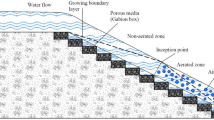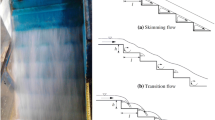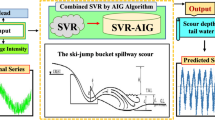Abstract
In the present study a physical model of a stepped vertical overfall (SVO) spillway is proposed and designed as a novel combination of a free overfall spillway with horizontal steps. First, the hydraulic design characteristics of the proposed spillway were discussed using a laboratory-scaled model. Effective parameters on the energy dissipation rate were defined as the relative critical depth, Froude number, number of steps, and dimensionless steps’ geometry parameter using dimensional analysis. The energy dissipation rate of the stepped vertical overfall spillway is measured using a waterwheel laboratory setup. Different geometry and hydraulic scenarios were used to assess the energy dissipation rate variation of the proposed spillway. Furthermore, Support Vector Regression and Random Forest Regression methods were used to estimate the energy dissipation of the proposed structure. Investigating the energy dissipation rate of 27 geometry scenarios with the available range of discharge revealed that the energy dissipation rate against the water’s relative depth inside the SVO spillway follows a gradually increasing trend ranging between 88.53% to 98.06%. Also, random forest regression algorithm showed more accurate prediction performance than support vector regression approach with RMSE = 0.128 and R2 = 0.99 in training stage and RMSE = 0.115 and R2 = 0.99 in testing stage. The support vector regression model estimated the proposed spillway’s energy dissipation rate with an accuracy of RMSE = 0.67 and R2 = 0.88 in training stage and RMSE = 0.61 and R2 = 0.9 in testing stage.
Similar content being viewed by others
References
Ahmadi M, Hatami M, Rahgozar P, Shirkhanloo S, Abed S, Kamalzadeh H, Flood I (2020) Development of an ESCO risk assessment model as a decision-making tool for the energy savings certificates market regulator: A case study. Applied Sciences 10(7):2552, DOI: https://doi.org/10.3390/app10072552
Ahmari H, Baharvand S, Pebworth M (2021) Developing an ArcGIS pro toolkit for assessing bridge construction effects on sediment regime and aquatic habitat. 20th Iranian Hydraulic Conference, October 27–28, Faculty of Water and Soil Engineering, Gorgan University of Agricultural Sciences and Natural Resources, Gorgan, Iran
Al-Fawzy AM, Al-Mohammed FM, Al-Fatlawi TJ, Al-Zubaidy RZ (2020) Dissipation energy of flow by stepped type gabion weir. IOP Conference Series: Materials Science and Engineering 737(1): 012158, DOI: https://doi.org/10.1088/1757-899X/737/1/012158
Baharvand S, Lashkar-Ara B (2021) Hydraulic design criteria of the modified meander C-type fishway using the combined experimental and CFD models. Ecological Engineering 164:106207, DOI: https://doi.org/10.1016/j.ecoleng.2021.106207
Baharvand S, Ahmari H, Taghvaei P (2022) Developing a lagrangian sediment transport model for natural streams. International Journal of Sediment Research, DOI: https://doi.org/10.1016/j.ijsrc.2022.09.003
Baharvand S, Jozaghi A, Fatahi-Alkouhi R, Karimzadeh S, Nasiri R, Lashkar-ara B (2021) Comparative study on the machine learning and regression-based approaches to predict the hydraulic jump sequent depth ratio. Iranian Journal of Science and Technology, Transactions of Civil Engineering 45(4):2719–2732, DOI: https://doi.org/10.1007/s40996-020-00526-2
Breiman L (2001) Random forests. Machine Learning, DOI: https://doi.org/10.1023/A:1010933404324
Chanson H (1995) History of stepped channels and spillways: A rediscovery of the wheel. Canadian Journal of Civil Engineering, DOI: https://doi.org/10.1139/195-034
Chinnarasri C, Wongwises S (2006) Flow patterns and energy dissipation over various stepped chutes. Journal of Irrigation and Drainage Engineering 132(1):70–76, DOI: https://doi.org/10.1061/(ASCE)0733-9437(2006)132:1(70)
Christodoulou GC (1993) Energy dissipation on stepped spillways. Journal of Hydraulic Engineering 119(5):644–650, DOI: https://doi.org/10.1061/(ASCE)0733-9429(1993)119:5(644)
Darabnoush Tehrani A, Kohankar Kouchesfehani Z, Najafi M (2021) Review and recommendations for structural testing of buried gravity storm drain pipes and culverts. Canadian Journal of Civil Engineering 48(2):173–186, DOI: https://doi.org/10.1139/cjce-2020-0049
Ekmekcioǧlu Ö, Başakın EE, Özger M (2020) Tree-based nonlinear ensemble technique to predict energy dissipation in stepped spillways. European Journal of Environmental and Civil Engineering 1–19, DOI: https://doi.org/10.1080/19648189.2020.1805024
Fathinezhad A, Jafari N, Oldenburg CM, Caldwell MD (2020) Investigating air intrusion and aerobic reactions in municipal solid waste landfills. In AGU Fall Meeting Abstracts, H202-07, 2020
Fathinezhad A, Jafari N, Oldenburg CM, Caldwell MD (2022) Numerical investigation of air intrusion and aerobic reactions in municipal solid waste landfills. Waste Management 147(2022):60–72, DOI: https://doi.org/10.1016/j.wasman.2022.05.009
Haghiabi AH (2016) Prediction of longitudinal dispersion coefficient using multivariate adaptive regression splines. Journal of Earth System Science 125(5):985–995, DOI: https://doi.org/10.1007/s12040-016-0708-8
Hassanzadeh Y, Ghazvinian M, Abdi A, Baharvand S, Jozaghi A (2020) Prediction of short and long-term droughts using artificial neural networks and hydro-meteorological variables. arXiv preprint, DOI: https://doi.org/10.48550/arXiv.2006.02581
Hong JH, Goyal MK, Chiew YM, Chua LHC (2012) Predicting time-dependent pier scour depth with support vector regression. Journal of Hydrology 468–469, 241–248, DOI: https://doi.org/10.1016/j.jhydrol.2012.08.038
Jiang L, Diao M, Xue H, Sun H (2018) Energy dissipation prediction for stepped spillway based on genetic algorithm—Support vector regression. Journal of Irrigation and Drainage Engineering 144(4):04018003, DOI: https://doi.org/10.1061/(ASCE)IR.1943-4774.0001293
Jones AJ (1998) The winGamma — User Guide
Kabir SMI, Ahmari H (2020a) Evaluating the effect of sediment color on water radiance and suspended sediment concentration using digital imagery. Journal of Hydrology 589:125189, DOI: https://doi.org/10.1016/j.jhydrol.2020.125189
Kabir SMI, Ahmari H (2020b) Sediment color effects on the estimation of suspended sediment concentration from digital imagery. World Environmental and Water Resources Congress 2020, May 17–21, American Society of Civil Engineers, Reston, VA, 40–50
Khatibi R, Salmasi F, Ghorbani MA, Asadi H (2014) Modelling energy dissipation over stepped-gabion weirs by artificial intelligence. Water Resources Management 28(7):1807–1821, DOI: https://doi.org/10.1007/s11269-014-0545-y
Khatsuria RM (2004) Hydraulics of spillways and energy dissipators. CRC Press
Kohankar Kouchesfehani Z, Darabnoush Tehrani A, Najafi M (2021) Culvert renewal with cementitious-geopolymer spray—applied pipe lining: Field data collection and assessment. Journal of Pipeline Systems Engineering and Practice 12(3):04021028, DOI: https://doi.org/10.1061/%28ASCE%29PS.1949-1204.0000555
Lashkar-Ara B, Baharvand S, Najafi L (2021) Study the performance of data-driven models to predict the scour depth caused by the aerated vertical jet. Irrigation Sciences and Engineering (4):79–89, DOI: https://doi.org/10.22055/JISE.2021.36599.1959
Mohammad Rezapour Tabari M, Tavakoli S (2016) Effects of stepped spillway geometry on flow pattern and energy dissipation. Arabian Journal for Science and Engineering, DOI: https://doi.org/10.1007/s13369-015-1874-8
Parsaie A, Haghiabi AH, Saneie M, Torabi H (2016) Prediction of energy dissipation on the stepped spillway using the multivariate adaptive regression splines. ISH Journal of Hydraulic Engineering 22(3):281–292, DOI: https://doi.org/10.1080/09715010.2016.1201782
Pedregosa F, Varoquaux G, Gramfort A, Michel V, Thirion B, Grisel O, Blondel M, Prettenhofer P, Weiss R, Dubourg V, Vanderplas J, Passos A, Cournapeau D, Brucher M, Perrot M, Duchesnay É (2011) Scikit-learn: Machine learning in python. Journal of Machine Learning Research 12(85):2825–2830
Puttinaovarat S, Horkaew P (2020) Flood forecasting system based on integrated big and crowdsource data by using machine learning techniques. IEEE Access 8:5885–5905, DOI: https://doi.org/10.1109/ACCESS.2019.2963819
Rice SP, Lancaster J, Kemp P (2010) Experimentation at the interface of fluvial geomorphology, stream ecology and hydraulic engineering and the development of an effective, interdisciplinary river science. Earth Surface Processes and Landforms 35(1):64–77, DOI: https://doi.org/10.1002/esp.1838
Roushangar K, Akhgar S, Salmasi F, Shiri J (2014) Modeling energy dissipation over stepped spillways using machine learning approaches. Journal of Hydrology 508:254–265, DOI: https://doi.org/10.1016/j.jhydrol.2013.10.053
Salmasi F, Özger M (2014) Neuro-fuzzy approach for estimating energy dissipation in skimming flow over stepped spillways. Arabian Journal for Science and Engineering 39(8):6099–6108, DOI: https://doi.org/10.1007/s13369-014-1240-2
Samani ZA, Baharvand S, Davis S (2021) Calibration of stage—discharge relationship for rectangular flume with central cylindrical contraction. Journal of Irrigation and Drainage Engineering 147(8):06021006, DOI: https://doi.org/10.1061/(ASCE)IR.1943-4774.0001595
Shirkhanloo S, Najafi M, Kaushal V, Rajabi M (2021) A comparative study on the effect of class C and class F fly ashes on geotechnical properties of high-plasticity clay. CivilEng 2(4):1009–1018, DOI: https://doi.org/10.3390/civileng2040054
Wan W, Raza A, Chen X (2019) Effect of height and geometry of stepped spillway on inception point location. Applied Sciences (Switzerland), DOI: https://doi.org/10.3390/app9102091
Zhang G, Chanson H (2016) Hydraulics of the developing flow region of stepped spillways. I: Physical modeling and boundary layer development. Journal of Hydraulic Engineering 142(7):04016015, DOI: https://doi.org/10.1061/(ASCE)HY.1943-7900.0001138
Zhou J, Shi J, Li G (2011) Fine tuning support vector machines for short-term wind speed forecasting. Energy Conversion and Management 52(4):1990–1998, DOI: https://doi.org/10.1016/j.enconman.2010.11.007
Zhu M (2012) Kernels and ensembles. The American Statistician 62(2):97–109, DOI: https://doi.org/10.1198/000313008X306367
Acknowledgments
The authors would like to thank Shiraz University for their support during the physical modeling.
Author information
Authors and Affiliations
Corresponding author
Rights and permissions
About this article
Cite this article
Baharvand, S., Rezaei, R., Talebbeydokhti, N. et al. Investigation of Energy Dissipation Rate of Stepped Vertical Overfall (SVO) Spillway Using Physical Modeling and Soft Computing Techniques. KSCE J Civ Eng 26, 5067–5081 (2022). https://doi.org/10.1007/s12205-022-1870-y
Received:
Revised:
Accepted:
Published:
Issue Date:
DOI: https://doi.org/10.1007/s12205-022-1870-y




